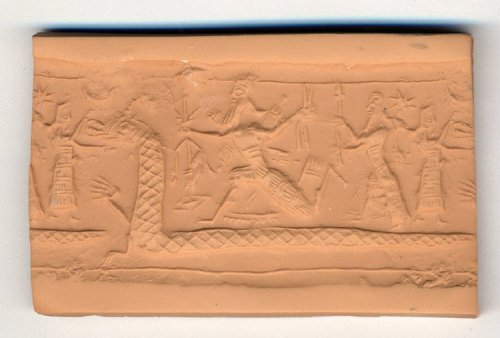Points of Correspondence Between Genesis and the Enuma Elish
” … It would be tempting to trace the framework of the Seven Days of Creation, upon which the narrative in Genesis is stretched, to the influence of the Seven Tablets of Creation, of which we now know that the great Creation Series was composed. The reasons for the employment of the Seven Days in the Hebrew account are, however, not the same which led to the arrangement of the Babylonian poem upon Seven Tablets.
In the one the writer’s intention is to give the original authority for the observance of the Sabbath; in the other there appears to have been no special reason for this arrangement of the poem beyond the mystical nature of the number “seven.”
Moreover, acts of creation are recorded on all of the first six Days in the Hebrew narrative, while in the Babylonian poem the creation only begins at the end of the Fourth Tablet. 1 The resemblance, therefore, is somewhat superficial, but it is possible that the employment of the number “seven” in the two accounts was not fortuitous.
Whether the Sabbath was of Babylonian origin (as seems probable) or not, it is clear that the writer of the narrative in Genesis was keenly interested in its propagation and its due observance. Now in Exilic and post-Exilic times the account of the Creation most prevalent in Babylonia was that in the poem Enuma elish, the text of which was at this time absolutely fixed and its arrangement upon Seven Tablets invariable.
That the late revival of mythology among the Jews was partly due to their actual study of the Babylonian legends at this period is sufficiently proved by the minute points of resemblance between the accounts of the Deluge in Genesis and in the poem of Gilgamesh. 1
It is probable, therefore, that the writer who was responsible for the final form of Gen. i-ii, 4a, was familiar with the Babylonian legend of Creation in the form in which it has come down to us. The supposition, then, is perhaps not too fanciful, that the connection of the Sabbath with the story of Creation was suggested by the mystical number of the Tablets upon which the Babylonian poem was inscribed.
Further resemblances to the Babylonian Creation legends may be traced in the second Hebrew account of the Creation which follows the first in Gen. ii, 4b-7. According to this version man was formed from the dust of the ground, which may be compared to the mixing of Bel’s blood with earth according to the account of Berossus, the use of the Creator’s blood in the one account being paralleled by the employment of His breath in the other for the purpose of giving life to the dust or earth.
Earth is not mentioned in the recovered portion of the Sixth Tablet, but its use in the creation of men is fully in accordance with Babylonian beliefs. Thus, according to the second Babylonian account of the Creation, 1 Marduk formed man by pouring out dust beside a reed which he had set upon the face of the waters. Clay is also related to have been employed in the creation of special men and heroes; thus it was used in Ea-bani’s creation by Arum, 2 and it is related to have been mixed with divine blood for a similar purpose in the fragmentary legend Bu. 91-5-9, 269. 3
To the account of the creation of woman in Gen. ii, 18 ff. we find a new parallel in l. 5 of the Sixth Tablet of the Creation Series, in the use of the word issimtu, “bone,” corresponding to the Hebrew ‘esem which occurs in the phrase “bone of my bones” in Gen. ii, 23.
In addition to the Babylonian colouring of much of the story of Paradise we may now add a new parallel from the Babylonian address to a mythical River of Creation, inscribed on S. 1704 and the Neo-Babylonian Tablet 82-9-18, 5311. 1
This short composition is addressed to a River to whom the creation of all things is ascribed, 2 and with this river we may compare the mythical river of Paradise which watered the garden, and on leaving it was divided into four branches.
That the Hebrew River of Paradise is Babylonian in character is clear; and the origin of the Babylonian River of Creation is also to be found in the Euphrates, from whose waters southern Babylonia derived its great fertility. 3 The life-giving stream of Paradise is met with elsewhere in the Old Testament, as, for instance, in Ezekiel xlvii, and it is probable that we may trace its influence in the Apocalypse.”1
Leonard William King, The Seven Tablets of Creation, London, 1902. pp. xci-xcv.


 begins with a description of the Creation and then goes on to describe a Flood, and there is little doubt that certain passages in this text are the originals of the Babylonian version as given in the Seven Tablets.
begins with a description of the Creation and then goes on to describe a Flood, and there is little doubt that certain passages in this text are the originals of the Babylonian version as given in the Seven Tablets. .
. , Ilu Nagar Ilu Nagar, i.e., “the workmen gods,” about whom nothing is known.
, Ilu Nagar Ilu Nagar, i.e., “the workmen gods,” about whom nothing is known.